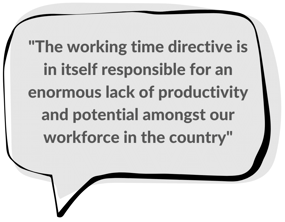No one can be sure what else will have happened by the time this is published!
In the middle of this turmoil, and gone quite unnoticed by many, is The Retained EU Law Bill, due for second reading in the Commons. If the political will is maintained and this is put into legislation, it would automatically scrap many worker protections at the end of the year, unless ministers actively choose to keep them. Many of these rights were brought into law from the EU Working Time Directive and initially put into UK law in the 1998 Working Time Regulations. In theory, these protections could be replaced by watered down versions – putting into question legal requirements for rest breaks, working time limits, holiday and other leave entitlements.
 But the question is why is this happening? Whilst most press coverage has heavily covered The Four Day Week and Hybrid Working this possible reduction in rights has widely slipped under the radar. Seemingly, there is a perceived issue that it is the cause of an underlying productivity malaise in the UK, as expressed by some MPs.
But the question is why is this happening? Whilst most press coverage has heavily covered The Four Day Week and Hybrid Working this possible reduction in rights has widely slipped under the radar. Seemingly, there is a perceived issue that it is the cause of an underlying productivity malaise in the UK, as expressed by some MPs.
However, if we examine data from the -1.png?width=285&height=286&name=workers%20rights%20or%20wrongs%20blog%20(2)-1.png) Organisation for Economic Co-operation and Development (OECD) and Office for National Statistics calculations using comparative methodologies, then this perception can rightly be questioned.
Organisation for Economic Co-operation and Development (OECD) and Office for National Statistics calculations using comparative methodologies, then this perception can rightly be questioned.
Taking the UK’s level as 100, this graph shows that the UK’s output per hour worked is less than France and Germany, both in the EU with similar working time legislation, and also the US, but greater than Italy, again in the EU, Canada and Japan.
We have previously talked about the impact of long hours working, where we discussed research by Nevison (Nevison, John M, "Overtime Hours: The Rule of Fifty") that demonstrated employee productivity will not increase linearly with extended working hours. In fact it shows that, for most, little productive work takes place over and above 50 hours per week. It also examines the cumulative effect showing that productive hours drop as consecutive long work weeks increase.
In the Review of Modern Working Practices, Matthew Taylor concluded that “Working longer hours increases the risk of occupational illness (such as stress and mental health problems)” but also agreed that “the duration of work is an important factor in the indicators of quality of work”.
So there are not only productivity issues but also risks to employee health from working long hours. The known risks may include:
- heart and stroke problems
- general fatigue
- back injuries
- increased blood pressure
- an escalation in mental health issues
- in women, a reduction in birth weights of their children
- higher alcohol consumption
- higher suicide rates
These health problems are not only of great importance to the individual, they also may lead to an increase in absenteeism. If these absences need covering to deliver effective operations, then they may cause additional overtime to be required from others, thereby increasing the number of hours individual team members are working and making the problem self-perpetuating.
So, based on the available evidence, it is likely that losing these rights will do nothing for improving productivity and may well have a negative impact on worker health. In fact in recent polling 71% of voters supported retaining these EU-derived workers’ rights so it seems like this government may be storing up more problems for itself.
What exactly are these rights?
Without going into great detail, they include, amongst other rights:
Paid annual leave - Workers, who are in employment for a full leave year, are entitled to 5.6 weeks’ statutory leave. Those with irregular or annualised hours are still entitled to 5.6 weeks’ annual leave, but this can be converted into hours.
Rest breaks at work - Employees and workers have the right to a rest break of 20 minutes where the working day is longer than six hours. If workers are under eighteen, they are entitled to a 30-minute break after working four and a half hours. Employers can say when employees take rest breaks during work time as long as:
- the break is taken in one go somewhere in the middle of the work period
- they are allowed to spend it away from where they actually work
This legislative right does not mean an employer must allow smoking breaks or even pay for rest breaks.
Daily rest - Workers have the right to 11 hours rest between working days.
Weekly rest - Workers have the right to either:
- an uninterrupted 24 hours without any work each week
- an uninterrupted 48 hours without any work each fortnight
Working week - Employees have the right not to work more than 48 hours a week normally averaged over a 17-week period, but this period could be extended by agreement if there are objective or technical reasons concerning the organisation of work. This may be where, for instance, workers are on annualised hours contracts. There is the ability to opt out of this right for a maximum of 48 hours average week.